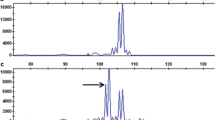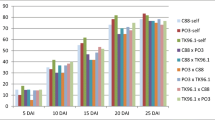Summary
Bacterial ring rot of potato (Solanum tuberosum) has not been successfully controlled through management of certified seed. Therefore, the identification of immunity to this pathogen and its introgression into the cultivated potato is vitally important to the potato industry. Immunity was detected in the disomic tetraploid 2EBN (Endosperm Balance Number) species S. acaule. Immune and nonimmune parents were crossed in a 4 × 4 mating scheme that consisted of four immune × immune crosses, four immune × nonimmune, four nonimmune × immune, and four nonimmune × nonimmune crosses. Analysis was performed on the 16 F1 populations and 54% of the progeny was found to exhibit an immune response to inoculation with Clavibacter michiganensis subsp. sepedonicus (Spieck & Kotth.) Davis et al. Immunity appears to be conferred by two dominant alleles, one at each locus, and may be associated with minor or modifying genes. Phenotypic expression of nonimmune progeny ranged from susceptible to resistant, probably due to minor or modifying genes. These results indicate that it may not be difficult to transfer immunity into the cultivated potato.
Similar content being viewed by others
References
Baer, D. & N.C.Gudmestad, 1991. Serological detection of nonmucoid strains of Clavibacter michiganensis subsp. sepedonicus in potato. Phytopathology 82: 83: 157–163.
Bishop, A.L. & S.A.Slack, 1987. Effect of inoculum dose and preparation, strain variation, and plant growth conditions in the eggplant assay for bacterial ring rot. Am. Potato J. 64: 227–234.
Bonde, R., F.J.Stevenson, C.F.Clark & R.V.Akeley, 1942. Resistance of certain potato varieties and seedling progenies to ring rot. Phytopathology 32: 813–819.
Bonde, R. & M.Covell, 1950. Effect of host variety and other factors on pathogenicity of potato ring rot bacteria. Phytopathology 40: 161–172.
Brown, C.R. & K.Adiwilaga, 1990. Introgression of Solanumacaule germ plasm from the endosperm balance number 2 gene pool into the cultivated endosperm balance number 4 potato gene pool via triplanroids. Genome 33: 273–278.
DeBoer, S.H. & A.Wieczorek, 1984. Production of monoclonal antibodies to Corynebacterium sepedonicum. Phytopathology 74: 1431–1434.
DeBoer, S.H. & M.E.McNaughton, 1984. Evaluation of immunofluorescence with monoclonal antibodies for detecting latent bacterial ring rot infections. Am. Potato J.63: 533–543.
DeBoer, S.H. & M.McCann, 1990. Detection of Corynebacterium sepedonicum in potato cultivars with different propensities to express ring rot symptoms. Am. Potato J. 67: 685–694.
Dionne, L.A., 1961. Mechanisms of interspecific incompatibility in tuber-bearing Solanum species. Am. Potato J. 38: 73–77.
Gutbrod, O., 1987. Certification policies and practices in reference to bacterial ring rot. Am. Potato J. 64: 677–681.
Kameraz, A.Y., M.A.Vavilova, N.A.Zhitlova & V.N.Ivanova, 1978. Interspecific hybridization of the potato involving wild species of the Series Acaulia Juz. pp. 115–138. In: Systematics, Breeding and Seed Production of Potato. Printsman Press, Faridad.
Kriel, C.J., S.H.Jansky, N.C.Gudmestad & D.H.Ronis, 1995. Immunity to Clavibacter michiganensis subsp. sepedonicus: Screening of exotic Solanum species. Euph 82(2): 125–132.
Kurowski, C.J. & F.E.Manzer, 1992. Reevaluation of Solanum species accessions showing resistance to bacterial ring rot. Am. Potato J. 69: 289–297.
Logsdon, C.E., 1967. Effect of soil temperature on potato ring rot. Am. Potato J. 69: 281–286.
Manzer, F.E. & A.R.McKenzie, 1988. Cultivar response to bacterial ring rot infection in Maine. Am. Potato J. 65: 333–339.
Mastenbroek, C., 1956. Some experiences in breeding frost-tolerant potatoes. Euphytica 5: 289–297.
Miller, H.J., 1984. A method for the detection of latent ring rot in potatoes by immunofluorescence microscopy. Potato Res. 27: 33–42.
Nelson, G.A., W.E.Torfason & F.R.Harper, 1971. Comparison of inoculation methods in ring rot development in potato. Am. Potato J. 48: 225–229.
Nelson, G.A., 1982. Corynebacterium sepedonicum in potato: effect of inoculum concentration on ring rot symptoms and latent infections. Can. J. Plant Pathol. 4: 129–133.
Nelson, G.A. & G.C.Kozub, 1983. Effect of total light energy on symptoms and growth of ring rot-infected Red Pontiac potato plants. Am. Potato J. 60: 461–468.
Nelson, G.A. & G.C.Kozub, 1987. Effect of temperature and latent viruses on atypical ring rot symptoms of Russet Burbank potatoes. Am. Potato J. 64: 589–597.
Racicot, H.N., D.B.O.Savile & I.L.Conners, 1938. Bacterial wilt and rot of potatoes-some suggestions for its detection, verification, and control. Am. Potato J. 15: 312–318.
Rowe, P.R., 1969. Nature, and distribution and use of diversity in the tuber-bearing Solanum species. Econ. Bot. 23: 330–338.
Rudorf, W., 1958. The significance of wild species for potato breeding. Eur. Potato J. 1: 10–20.
Schaad, M.W. (ed.), 1980. Lab Guide for Identification of Plant Pathogenic Bacteria. Ann. Phytopathol. Soc. St. Paul, Minn.
Scherf, A.F., 1949. Root inoculation, a method insuring uniform rapid symptom development of bacterial ring rot of potato. Phytopathology 39: 507–508.
Swaminithan, M.S., 1954. Nature of polyploidy in some 48 chromosome species of the Genus Solanum Section Tuberarium. Genetics 39: 59–76.
Author information
Authors and Affiliations
Rights and permissions
About this article
Cite this article
Kriel, C.J., Jansky, S.H., Gudmestad, N.C. et al. Immunity to Clavibacter michiganensis subsp. sepedonicus: Inheritance of immunity in Solanum acaule . Euphytica 82, 133–139 (1995). https://doi.org/10.1007/BF00027059
Received:
Accepted:
Issue Date:
DOI: https://doi.org/10.1007/BF00027059




